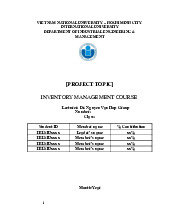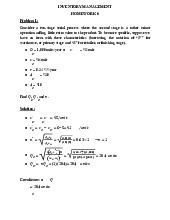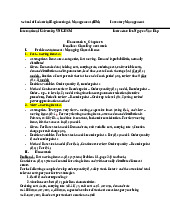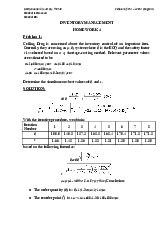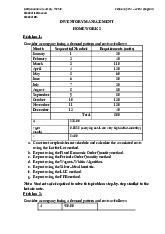





Preview text:
lOMoAR cPSD| 58605085
International University, HCMC
School of IEM – LSCM Program Student Full name: Student ID: INVENTORY MANAGEMENT HOMEWORK 1
Problem 1: A manufacturing company based in Calgary manufactures a product
with a three-month supply cycle. An analyst is working to introduce a more
rational method for determining production quantities and has acquired the
following estimates regarding the item's attributes: We have: • A: ordering cost • D: annual demand
• r*v : holding cost per year
a) EOQ = SQRT(2*4000*5/0.04*0.25) = 2000 units
The economic order quantity of the item is 2000 units b)
Time between consencutive replenishment T=EOQ/D = 2000/4000=0.5 years
Since we need this in month, we can multiply by 12 T = 0.5 * 12=6 months
Time between consencutive replenishment is 6 months c) Range of A?
- Qthree-month=D/numbers of order per year = 4000/4=1000 units
- TCEOQ = (4000/2000)*5 + (2000/2)*0.01=2*5+1000*0.1=10+10=20 dollars
- TCthree-month=(D/Qthree-month) *A + (Qthree-month/2)*r*v=(4000/1000) *A + lOMoAR cPSD| 58605085
International University, HCMC
School of IEM – LSCM Program Student Full name: Student ID: (1000/2)*0.01=4A+500*0.1=4A+5 - For EOQ to be preferable TCEOQ < TCthree-month 20 < 4A + 5 A>3.75
Problem 2: The famous Ernie of Sesame Street continually faces replenishment
decisions concerning his cookie supply. The Cookie Monster devours the cookies
at an average rate of 200 per day. The cookies cost $0.03 each. Ernie is getting
fed up with having to go to the store once a week. His friend Bert has offered to
do a study to help Ernie with his problem.
a. If Ernie is implicitly following an EOQ policy, what can Bert say about the
implicit values of the two missing parameters?
Bert can determine the two missing parameters of the EOQ (Economic
Order Quantity) policy by using the following formula:
EOQ = sqrt((2 * D * S) / H) Where: •
D is the demand rate (cookies consumed per day) • S is the setup cost per order •
H is the holding cost per unit per year
Given that Ernie devours cookies at a rate of 200 per day and the cookies
cost $0.03 each, Bert can calculate the EOQ by substituting these values
into the formula. However, the setup cost per order and the holding cost per
unit per year are missing from the problem statement. Without these values,
Bert cannot determine the exact EOQ, but he can explain the concept and
importance of the EOQ policy to Ernie.
b. Suppose that the store offered a special of 10,000 cookies for $200. Should
Ernie take advantage of the offer? Discuss. (Hint: Consult your local TV
listing for the timing of and channel selection for Sesame Street)
To determine whether Ernie should take advantage of the offer, Bert needs to
compare the cost of the special offer with the cost of ordering cookies using the EOQ policy.
If Ernie takes advantage of the special offer, he will get 10,000 cookies for $200,
which means the cost per cookie would be $200/10,000 = $0.02. lOMoAR cPSD| 58605085
International University, HCMC
School of IEM – LSCM Program Student Full name: Student ID:
If Ernie orders cookies using the EOQ policy, he would need to calculate the cost
per cookie based on the EOQ formula. However, since the setup cost per order
and the holding cost per unit per year are missing, Bert cannot calculate the exact
cost per cookie using the EOQ policy.
Therefore, Bert cannot definitively say whether Ernie should take advantage of
the offer without knowing the missing parameters of the EOQ policy. However,
Bert can explain to Ernie the importance of comparing the cost per cookie from
the special offer with the cost per cookie calculated using the EOQ policy, and
help Ernie make an informed decision based on the available information.
Problem 3: A mining company routinely replaces a specific part on a certain type
of equipment. The usage rate is forty per week, and there is no significant
seasonality. The supplier of the part offers the following all-units discount structure. Range Q Unit cost 0 < Q < 300 units $10.00 Q >= 300 $9.7
The fixed cost of a replenishment is estimated to be $25, and a carrying charge of
0.26 $/$/yr. is used by the company.
a. What replenishment size should be used?
In this case, the usage rate is 40 units per week, so the annual demand is 40
* 52 = 2080 units. The fixed cost of replenishment is $25, and the carrying charge rate is 0.26 $/$/yr.
Plugging these values into the EOQ formula, we get:
EOQ = sqrt((2 * 2080 * 25) / 0.26)
Simplifying the equation, we find: EOQ ≈ 300.77
Since we can't order a fraction of a unit, the replenishment size should be
rounded up to the nearest whole number. Therefore, the recommended
replenishment size is 301 units. lOMoAR cPSD| 58605085
International University, HCMC
School of IEM – LSCM Program Student Full name: Student ID:
b. If the supplier was interested in having the mining company acquire at least
500 units at a time, what is the largest unit price they could charge for an order of 500 units?
To find the largest unit price for an order of 500 units, we need to compare
the total cost of ordering 500 units at different unit prices.
The total cost (TC) is given by:
TC = (Q * C) + (D * S / Q) + (Q * H * C / 2) Where: •
Q is the order quantity (500 units in this case) • C is the unit cost • D is the annual demand •
S is the fixed cost of replenishment • H is the carrying charge rate
We want to find the largest unit price (C) that still results in a lower total
cost than ordering at the discounted price of $9.7 per unit.
By substituting the given values into the total cost formula, we can calculate
the total cost for an order of 500 units at different unit prices. We can then
compare these costs to find the largest unit price that meets the condition.
It is important to note that the given discount structure is for all-units,
meaning that the unit cost applies to the entire order quantity.
Unfortunately, the specific values for the range Q are not provided, so we
cannot calculate the exact largest unit price for an order of 500 units.
However, you can use the provided formula and substitute the values to
find the largest unit price that meets the condition.
Problem 4: A supplier offers the following discount structure on purchases of any single item: 0 < Q < 1000 $5.00 per unit 1000 <= Q < 2000 $4.90 per unit 2000 <= Q $4.75 per unit
The discounts apply to all units. For each of the following items treated separately,
what is the appropriate order quantity to use, assuming a common value of r = 0.3 $/$/yr.? Item D (units/yr.) A ($) 1 10,000 25 2 1,000 25 3 4,000 25 4 130,000 25
Let's calculate the EOQ for each item: lOMoAR cPSD| 58605085
International University, HCMC
School of IEM – LSCM Program Student Full name: Student ID: Item 1: • D = 10000 units/year •
S = $4.75/unit (since 2000 ≤ Q) • A = $25 • r = 0.3 $/$/yr
EOQ = sqrt((2 * 10000 * 4.75) / (0.3 * 25)) = sqrt(31666.67) ≈ 177.7 units Item 2: • D = 1000 units/year •
S = $4.9/unit (since 1000 ≤ Q < 2000) • A = $25 • r = 0.3 $/$/yr
EOQ = sqrt((2 * 1000 * 4.9) / (0.3 * 25)) = sqrt(3266.67) ≈ 57.2 units Item 3: • D = 4000 units/year •
S = $4.75/unit (since 2000 ≤ Q) • A = $25 • r = 0.3 $/$/yr
EOQ = sqrt((2 * 4000 * 4.75) / (0.3 * 25)) = sqrt(25333.33) ≈ 159.2 units Item 4: • D = 130000 units/year •
S = $4.75/unit (since 2000 ≤ Q) • A = $25 • r = 0.3 $/$/yr
EOQ = sqrt((2 * 130000 * 4.75) / (0.3 * 25)) = sqrt(5466666.67) ≈ 2339.4 units
Therefore, the appropriate order quantities for each item are approximately: • Item 1: 177.7 units • Item 2: 57.2 units • Item 3: 159.2 units lOMoAR cPSD| 58605085
International University, HCMC
School of IEM – LSCM Program Student Full name: Student ID: • Item 4: 2339.4 units
